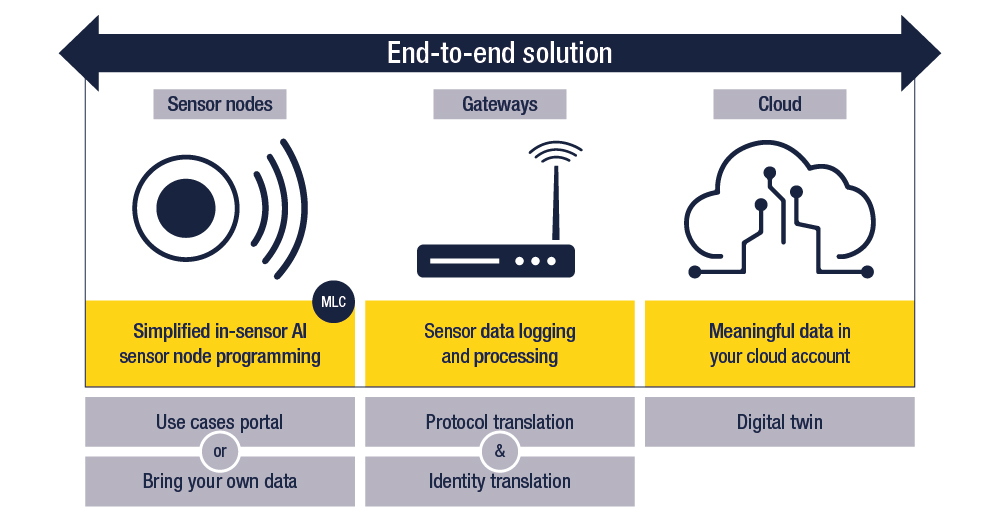ST is officially launching version 1.2 of ST AIoT Craft, the first online tool that helps program ST MEMS sensors equipped with a machine learning core (MLC) to run inference operations. It aims to be so intuitive as to make Artificial Intelligence of Things (AIoT) ubiquitous. The idea of running inference operations on a sensor is not new, and ST’s Machine Learning Core has been winning awards and enabling new types of applications for years. With this latest version, we are fostering collaboration and demonstrating our commitment to supporting the latest hardware, while also enhancing the user experience.
What’s new in AIoT Craft 1.2?
Sharing is caring
Two features introduced in version 1.2 are project sharing and dataset sharing. As the name suggests, the former enables users to combine models and classifiers from one project and share them with another. As we witness larger and larger teams utilizing AIoT Craft for multiple applications, adding this feature enables people from different groups to communicate with each other, share their work, and optimize their workflow. Similarly, we are also enabling dataset sharing, allowing multiple users to collect and work on the same data. It ensures that teams can increase the size of their sets or share cleanup operations for greater accuracy. Put simply, the new version of AIoT Craft focuses on collaboration.
New MEMS sensor support
Version 1.2 is also introducing support for our latest IMU sensors, the LSM6DSV80X and LSM6DSV320X, the first sensor to combine low-g and high-g accelerometers. AIoT is a recent solution from ST that we first talked about on the Blog in November 2024. Since then, we’ve already published an update to help developers do more with our software. And now, we are supporting our latest sensors. Version 1.2, therefore, demonstrates our commitment to continually improving our solution and providing rapid support for our devices, allowing developers to leverage our hardware quickly. In fact, beyond just basic support, we are shipping a demo application that utilizes the world of tennis to showcase the capabilities of the LSM6DSV80X and LSM6DSV320X.
FP-SNS-STAIOTCFT and Bluetooth connectivity
One key step during the development process consists of migrating from a development environment to a production one. In a nutshell, it often means porting code to a custom board that is close or identical to the final product. To make the process easier, ST came out with a firmware package, the FP-SNS-STAIOTCFT that works with STM32CubeMX to help developers port the application built with ST AIoT Craft. It’s also the reason why working with the entire ST ecosystem can significantly shorten development time. By using an STM32 MCU, developers can enjoy tools like STM32CubeMX that make it easier to run applications developed on ST AIoT Craft.
Another way to leverage the entire ST ecosystem is to utilize our wireless solutions. For instance, starting with version 1.2, ST AIoT Craft can use Bluetooth LE devices to connect sensor nodes to a gateway. It helps decrease power consumption compared to a more demanding wireless protocol, such as Wi-Fi. Additionally, our BLE stacks enable us to connect more than seven sensor nodes, which exceeds the capabilities of most competing solutions. Moreover, Bluetooth Low Energy opens the door to edge AI applications. As a sensor node makes an inference, it can quickly report it to the main microcontroller without significantly increasing energy consumption.
The challenges hindering the adoption of AIoT
Artificial Intelligence of Things first appeared almost 10 years ago in the context of medical devices and traffic solutions, among other things. As the name suggests, it marries AI and IoT. Hence, AIoT is a subset of the edge AI revolution and covers systems capable of processing data captured by IoT sensors. In contrast, machine learning at the edge encapsulates all systems capable of running AI algorithms (e.g., neural networks, random forests, decision trees, etc.) on an embedded system. As such, AIoT comes with its set of unique challenges. Resources are even more constrained than on traditional edge AI platforms, and it is critical to deal with the massive amount of data captured by the sensors, which can be overwhelming.
Additionally, many recognize the skills gap that makes creating machine-learning applications challenging. There’s an even more significant deficit regarding AIoT simply because the field is emerging, and the engineering hurdles can be even more complex. Teams must deal with new hardware, such as sensors with powerful application processing, instead of traditional sensors connected to microcontrollers. That makes the integration of AI algorithms into an application even more complex because of the resource constraints. Developers must also deal with a patchwork of software tools during the training and implementation phases that often require a wide range of expertise, from embedded systems development to AI frameworks.
The breaking down of barriers with ST AIoT Craft
ST has a long history of releasing software for Windows, macOS, Linux, iOS, and Android. Yet, we chose to make ST AIoT Craft a cloud solution to ensure it was more accessible, thus alleviating the skills gap. For instance, teams in corporate environments with restrictive IT policies can still take their development board, like the SensorTile.box PRO, connect it to their PC using a USB port, and start working on their AIoT project, regardless of the OS they run.
We offer pre-compiled application examples for evaluation, like asset tracking, human activity recognition, head gestures, and more. There’s also an ML auto function that automatically generates an MLC configuration file, and we offer the opportunity to customize the application example. Put simply, programmers with minimal experience in AIoT can see the code and gain real-world knowledge when using ST AIoT Craft.
Additionally, we felt it was important to tailor to more experienced users. Teams are more efficient if they can work on the same software solution. Hence, ST AIoT Craft has tools to deploy an end-to-end system by flashing a Raspberry Pi to turn it into a gateway that can collect data and connect to an Azure cloud instance. This setup can help more seasoned developers log data and control nodes remotely. The ST example gives users a free account on the Microsoft platform with 50 GB of storage. ST AIoT Craft also allows expert engineers to create a project from scratch, bring their data, generate their decision tree, and tweak it to optimize inference times and accuracy.

ST AIoT Craft is, therefore, a unique tool because it solves the new issues that can slow down the democratization of AIoT. Both novices and experts can work on the same platform and with the same goal in mind: rapidly creating and deploying an AIoT application on a sensor equipped with a machine learning core. No other tool on the market today can do that, and we felt it was critical to the democratization of AIoT. Indeed, running decision trees on a sensor has many advantages, from the massive energy savings since the MCU can stay in sleep mode to privacy implications, as data never leaves the sensor. It was thus essential to help popularize AIoT.
Expert mode
In response to the community’s enthusiasm around our solution, we are now releasing an MLC expert mode. From the beginning, we ensured that AIoT Craft would be accessible to developers with little experience in machine learning applications and those with a more extensive knowledge of the subject matter. Interestingly, this has led many experts to start adopting it. Hence, we are now opening our tool further by providing more configuration options to help engineers optimize inference operations and assist them in customizing their decision trees even more. Similarly, we are adding support for JSON format for MLC configuration files, so any developer can more rapidly read, edit, and port them from one project to the next.
Enhanced customer data protection
Another critical feature we are introducing with this new version of AIoT Craft is enhanced customer data protection. Developers can track their various IoT nodes on their Azure account and define policies based on their existing security protocols, thus safeguarding their company and customers’ privacy. This will also help entities comply with the increasingly stringent regulations governments are adopting and satisfy new market expectations. Finally, we are also introducing new data logging capabilities, fully compatible with ST High-Speed Datalog (FP-SNS-DATALOG2), to help track more information and format it in a way that can easily be used to create decision tree classifiers.
The first steps with ST AIoT Craft
The best way to try ST AIoT Craft is to grab one of the three development boards compatible with our solution: the SensorTile.box PRO, the STWIN.box, or the STWIN, and then go to our website. Users can download the firmware for their kit, which comes with demo applications. The cloud visualization tool will then show the information collected in real-time and the classifications performed by the Machine Learning Core. Furthermore, ST provides smartphone applications that can talk to one of the three kits to show the captured data and what is happening on the edge device. There’s also online documentation to help users navigate the platform and go deeper by deploying an end-to-end solution.
